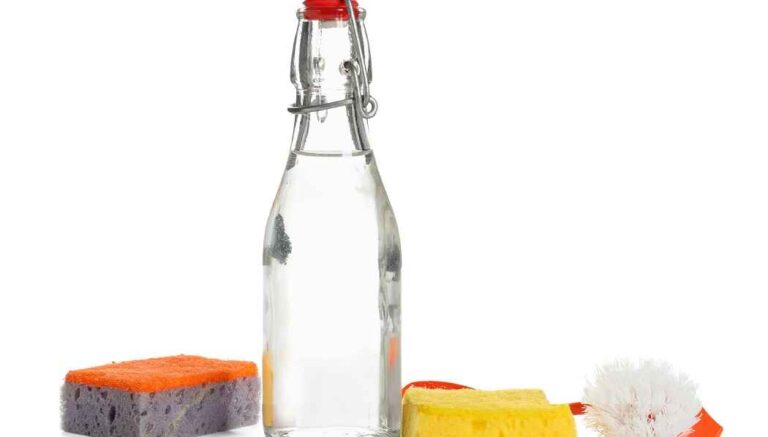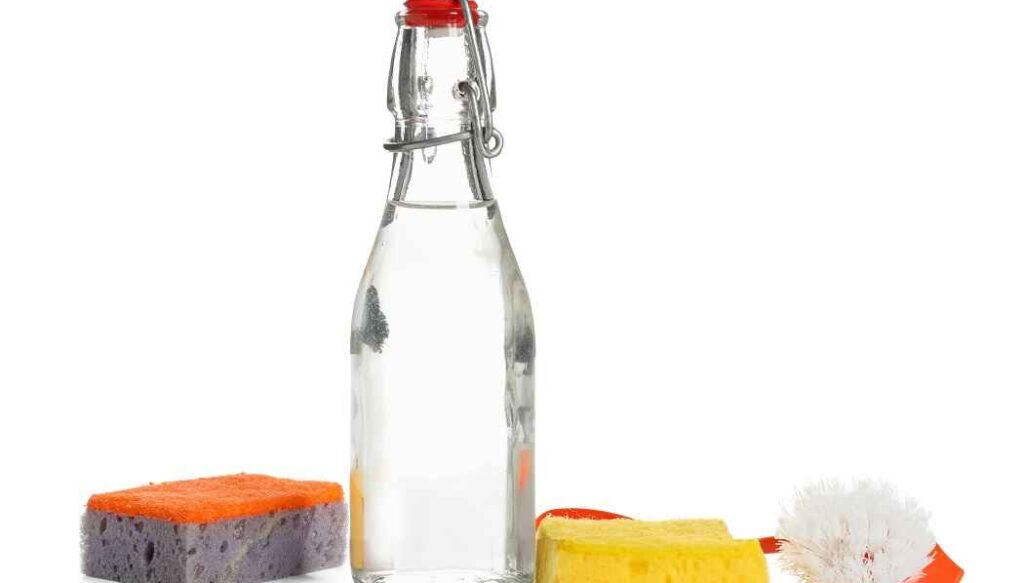
How to Remove Varnish from Wood with Vinegar?
To remove varnish from wood, create a solution by mixing equal parts of vinegar and water. Apply the solution to the varnished wood with a cloth and let it sit for a few minutes. Scrub off the varnish using a brush or sponge.

In this guide, we’ll walk you through the step-by-step process of using vinegar to remove varnish. This will be actually an affordable and eco-friendly alternative to harsh chemical strippers.
Get ready to discover a tried-and-true method that will rejuvenate your wood and bring out its natural beauty once again.
Understanding Varnish and Its Effects on Wood
Varnish is a transparent or semi-transparent coating. It is commonly used to protect and enhance the appearance of wood surfaces. It is a popular choice for finishing furniture, cabinetry, floors, and other wooden objects. Varnish provides several benefits to wood.
It creates a protective barrier on the surface. Varnish shields the wood surface from moisture, UV rays, and other environmental elements. This protective layer helps prevent the wood from warping, cracking, or rotting.
Varnish improves the look of its natural grain and color. It adds depth and richness to the wood surface. It can also be tinted or stained to alter the color of the wood or achieve a specific aesthetic.
Moreover, this coating improves the resistance of wood to scratches, stains, and abrasions. It provides a hard and smooth surface that is easier to clean and maintain. Regular maintenance (such as cleaning) can help preserve the appearance and integrity of the wood over time.
Remember, varnish can alter the texture and feel of the wood. Some people prefer the natural, untreated feel of wood. So, they may opt for other finishes like oil or wax. Besides, improper application of varnish can lead to issues such as uneven coverage, bubbling, or yellowing over time.
What Are the Natural Ways to Remove Varnish from Wood?
Removing varnish from wood can be done using natural methods that are effective and safe. Here are some natural ways to remove varnish from wood.
Heat and scraping: One method is to use heat to soften the varnish and then scrape it off. Start by using a heat gun or a hairdryer to warm up the varnish. Be cautious not to overheat or scorch the wood. Once the varnish becomes soft, gently scrape it off using a putty knife or a scraper. This method requires patience and care to avoid damaging the wood.
Vinegar: Soak a cloth or a sponge in white vinegar and apply it directly to the varnished surface. Let it sit for a few minutes, then scrub the area with a soft brush or cloth. The acetic acid in vinegar helps to break down the varnish, making it easier to remove. Rinse the wood with clean water afterward.
Citrus-based solvents: Citrus-based solvents, such as citrus peel extracts or orange oil, are effective natural alternatives for varnish removal. These solvents contain d-limonene, a powerful compound that can dissolve varnish. Apply the solvent to the varnished surface using a cloth or sponge. Wait for a few minutes. Then, use a scraper or a brush to remove the softened varnish.
Baking soda and water paste: Mix baking soda with water to form a thick consistency. Apply the paste onto the surface, ensuring an even layer. Leave it on for several hours to allow the mixture to penetrate the varnish. Once the paste has dried, scrape it off with a scraper. This method may require multiple applications for complete varnish removal.
How Vinegar Works for Removing Paint from Wood?
When it comes to removing paint, vinegar works by breaking down the chemical bonds that hold the paint together. It helps to loosen paint’s adhesion to the wood. This is a detailed explanation of how it works for removing paint from wood.
Acetic Acid Content: Vinegar contains acetic acid, which is a mild acid.The acid is typically around 5%, making it safe to handle but still potent enough to dissolve paint. It acts as a solvent, breaking down the chemical bonds in the paint and weakening its adherence to the wood.
Softening the Paint: When vinegar comes into contact with the paint, the acetic acid starts to soften the paint layers. It penetrates the paint and reacts with the chemicals in the paint, weakening the bonds between the paint molecules.
PH Balance: Vinegar has a low pH, typically around 2. This acidic nature helps to neutralize the alkaline properties of some types of paint, such as latex-based paints. By lowering the pH, it helps to break down the paint and make it easier to remove.
How to Remove Varnish from Wood with Vinegar?
If you’re looking to remove varnish from wood, using vinegar can be an effective and natural solution. Vinegar’s acidic properties help break down the varnish, making it easier to strip away. To remove varnish from wood using vinegar, you can follow these steps.
Necessary supplies:
- White vinegar
- Rubber gloves
- Safety goggles
- Soft cloth or sponge
- Plastic wrap
- Paintbrush
- Paint scraper
- Fine-grit sandpaper
- Clean water
Prepare the work area:
Choose a well-ventilated area to work in, as vinegar can produce strong odors. Lay down a protective drop cloth to prevent any damage to the surrounding surfaces.
Put on your safety gear:
- Wear rubber gloves to protect your hands from the vinegar.
- Put on safety goggles to shield your eyes from potential splashes.
Apply vinegar:
- Dip a soft cloth or sponge into white vinegar and gently rub it onto the varnished surface.
- Allow the vinegar sit on the wood for about 10-15 minutes. Thus, vinegar will penetrate and loosen the varnish.
Cover with plastic wrap:
- Once the vinegar has had time to work, cover the treated area with plastic wrap to prevent it from drying out.
- The plastic wrap will also help to enhance the effectiveness of the vinegar by keeping it in contact with the varnish.
Remove plastic wrap and varnish:
- After about 1-2 hours, remove the plastic wrap and inspect the wood.
- The varnish should have softened and lifted from the surface.
- Use a paint scraper to gently scrape away the loosened varnish.
- Be careful not to apply excessive pressure or damage the wood underneath.
Sand the wood:
- Once you have removed the majority of the varnish, use fine-grit sandpaper to sand the surface.
- Sanding will help to remove any residual varnish and smooth the wood.
- Sand in the direction of the wood grain for the best results.
Clean the surface:
- Wipe down the wood with a clean, damp cloth to remove any dust from sanding.
Repeat if necessary:
- If there are still traces of varnish remaining, you can repeat the process with vinegar.
Final steps:
- Once you have removed all the varnish, allow the wood to be dried completely.
- If desired, you can apply a new finish to the wood to protect and enhance its appearance.
Why Choose Vinegar Over Commercial Paint Strippers?
Removing paint from any surfaces, many people turn to commercial paint strippers due to their widespread availability and perceived effectiveness. But vinegar offers several advantages over commercial paint strippers. Take a look why vinegar can be a compelling choice for paint removal.
Safety: One of the significant advantages of using vinegar as a paint stripper is its safety. Commercial paint strippers often contain harsh chemicals such as methylene chloride. This chemical can be toxic and pose health risks if not handled properly. Vinegar, on the other hand, is a natural and non-toxic substance. It is a safer option for both the user and the environment.
Accessibility and affordability: Vinegar is readily available in most households. It can be purchased at a low cost from grocery stores. In contrast, commercial paint strippers may require a trip to a specialized store. And their prices can vary significantly depending on the brand and type of product. Using vinegar as a paint stripper can save both time and money.
Versatility: Vinegar is not only effective at removing paint from various surfaces, but it can also tackle other stubborn stains. It can be used on materials such as wood, metal, glass, and plastic. This versatility makes vinegar a multipurpose solution, providing additional value beyond just paint removal.
Ease of use: Vinegar is a user-friendly option for paint removal. Simply applying it to the painted surface and allowing it to sit for a period of time can help loosen the paint. This straightforward application process eliminates the need for complex instructions or specialized tools.
Environmentally friendly: Vinegar is biodegradable and does not release harmful fumes into the air during use. Its eco-friendly nature makes it a preferred option for those seeking to minimize their ecological footprint.
Safer for delicate surfaces: Some commercial paint strippers may be too harsh for delicate surfaces, causing damage or discoloration. Vinegar, being a milder solution, poses less risk to delicate materials and finishes.
What Kind of Vinegar Removes Paint from Wood?
White distilled vinegar is the recommended option to remove paint from wood. It is clear vinegar made from the fermentation of distilled alcohol, typically derived from grains such as corn.
This vinegar is widely available and known for its mild acidity. It is commonly used for various cleaning purposes due to its versatile nature.
When using vinegar for paint removal, it is important to dilute it with water to minimize the risk of damaging the wood. A mixture of equal parts white distilled vinegar and warm water is often used for this purpose.
Keep in mind that different types of vinegar, such as apple cider vinegar or wine vinegar may have varying levels of acidity. They may not be as effective as white distilled vinegar for paint removal from wood. Therefore, it is best to use white distilled vinegar when attempting to remove paint from wood surfaces.
Does Vinegar Damage Wood?
Vinegar can potentially damage wood if used improperly. Its acidic nature can cause the wood to lose its natural oils, leading to dryness. Prolonged or excessive exposure to vinegar can also strip the finish or varnish off the wood.
It is advisable to use mild, pH-neutral cleaners specifically formulated for wood surfaces to avoid any potential damage.
Conclusion
Vinegar to remove varnish from wood offers a practical and eco-friendly approach. But it can be a labor-intensive process, so it’s essential to be patient and take your time to achieve the desired results.
Throughout our discussion, we explored the steps involved in this process. You can just follow our instructions to effectively revive the natural allure of your wood furnishings.
